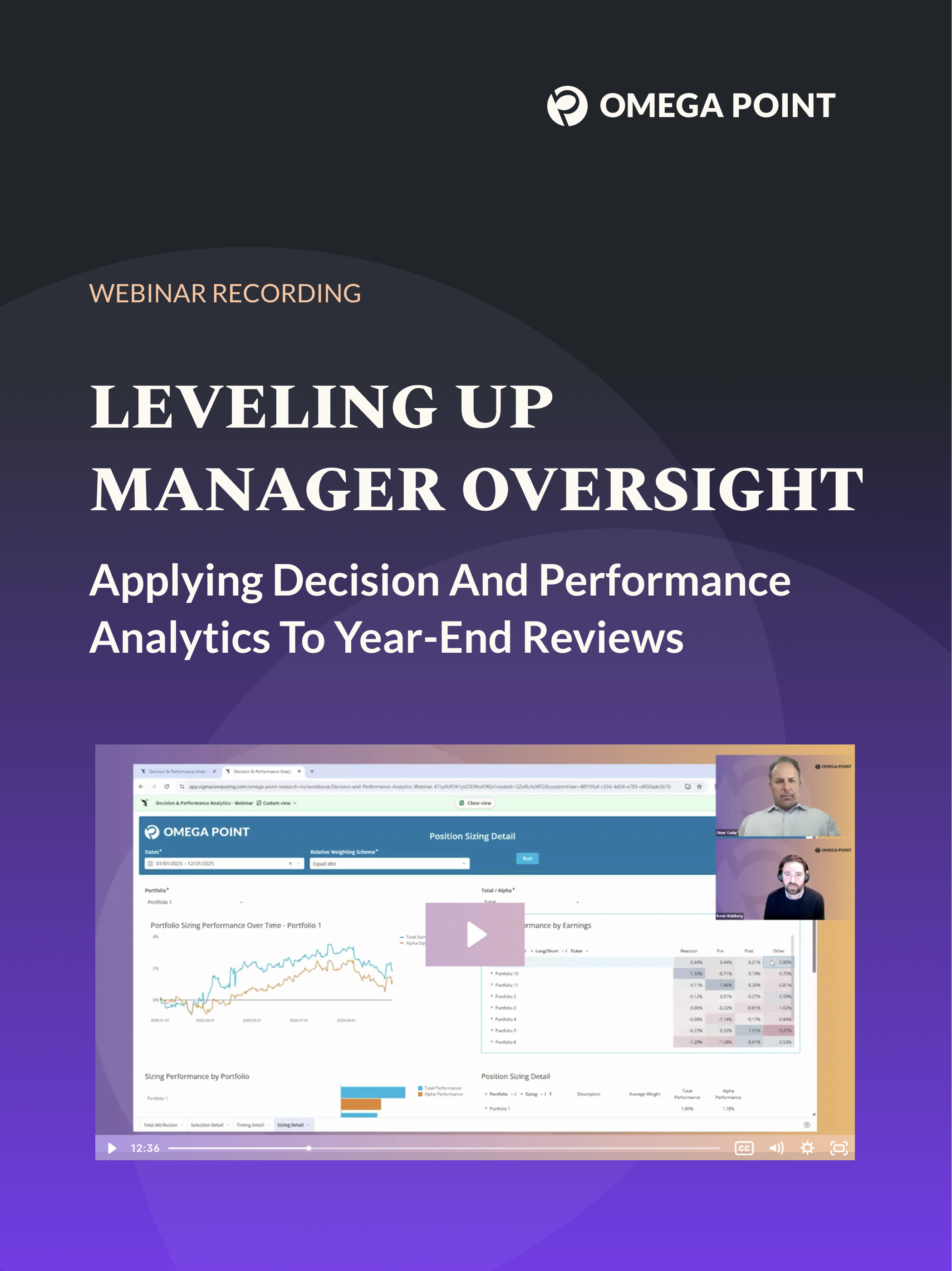Preparing for Year-End Decision and Performance Reviews
A Framework for Continuous Improvement
As the year comes to a close, most investment teams begin the familiar ritual of evaluating performance: what worked, what didn’t, and what can be learned. But the most effective reviews don’t stop at returns. They focus on decisions — the specific actions, allocations, and judgment calls that ultimately drive those returns.
This article offers an abridged decision-based approach to preparing for year-end reviews. This method is just as valuable for CIOs and risk teams as it is for individual portfolio managers reflecting on their own performance.
For a deeper dive into this topic, see our recent guide, Rethinking Manager Oversight, and register for our upcoming webinar, Applying Decision Performance Analytics to Year-End Reviews.
Leveling Up Year-End Reviews
Traditional reviews often concentrate on top-line results — alpha generation, drawdowns, and benchmark-relative performance. While necessary, these metrics rarely tell the full story.
Two managers might deliver the same returns through entirely different processes — one through consistent, skillful stock selection; the other through a single concentrated bet. Without understanding how returns are generated, it’s difficult to reward skill, correct weaknesses, or improve future outcomes.
A decision-level view introduces a more meaningful framework for accountability and development — one that isolates and quantifies the impact of distinct choices in the investment process.
The Four Core Decision Dimensions
A robust decision and performance review framework breaks down portfolio outcomes into four primary dimensions:
- Stock Selection – Did you consistently identify the right securities relative to your investment universe or benchmark?
- Trade Timing – Did entry and exit points add or detract from alpha?
- Gross/Net Management – Was the portfolio’s leverage and exposure profile aligned with conviction and risk tolerance?
- Position Sizing – Was capital allocated effectively to the best ideas, and was sizing adjusted appropriately as new information emerged?
By measuring returns through these lenses, you can determine which decisions added value and which detracted — the foundation for any meaningful year-end review.
From Outcome to Insight
The most productive reviews shift from performance outcomes to performance drivers.
- A manager whose selection has been strong but whose sizing consistently detracts may have a process bias resulting in over- under- allocation to certain names.
- Another may show strong timing skill but inconsistent gross/net management, suggesting a need to better align exposures with conviction.
The value of this approach lies in its diagnostic power. When these decision effects are measured consistently across time and managers, patterns emerge, revealing strengths to be reinforced and weaknesses to be addressed.
For practical examples of how firms are implementing this framework, explore our insights piece, Rethinking Manager Oversight.
Metrics That Matter
A decision-based review should include a handful of intuitive but powerful analytics, such as:
- Batting Average: How often did positions outperform peers?
- Slugging Percentage: When you were right, by how much? When you were wrong, how costly was it?
- Incremental Return from Sizing: Did capital allocation enhance or dilute selection skill?
- Peer Comparisons: How do these patterns stack up against others with similar mandates?
These metrics provide a common language for oversight discussions, grounded in evidence rather than narrative.
For Portfolio Managers: A Tool for Self-Reflection
While this framework helps CIOs and allocators evaluate performance, it’s equally powerful for portfolio managers preparing for their own reviews. Before sitting down for a formal evaluation, PMs can use decision-based metrics to:
- Identify persistent strengths and weaknesses in their process
- Quantify where intuition aligns (or conflicts) with results
- Build evidence-based narratives for their performance discussions
- Set tangible, measurable improvement goals for the year ahead
Simply being aware of decision-level deficits and monitoring them on an ongoing basis can be one of the most effective ways to drive improvement over time.
Peer Context and Constructive Oversight
Pairing managers against one another can be an effective way to capitalize on differences in decision style and process — especially across portfolios with similar mandates.
Equally powerful is the practice of ongoing self-monitoring. Many high-performing firms establish a cadence of reviewing decision analytics monthly or quarterly so that course corrections happen in real time rather than at year-end. Over time, this transforms the annual review from a post-mortem into a checkpoint within a continuous improvement cycle.
Building a Better Review Process
As firms refine their oversight frameworks, a few principles have proven most effective:
- Focus on decisions, not just results.
- Measure persistence. One good (or bad) year doesn’t define skill.
- Promote accountability through transparency. Decision-level metrics make oversight fair and objective.
- Encourage collaboration. Where one manager’s weakness aligns with another’s strength, there’s an opportunity for shared learning.
- Make it continuous. The best oversight frameworks operate year-round, not just at year-end.
Continue the Conversation
To explore how decision analytics can transform the year-end review process, watch the recording of our recent webinar:
Applying Decision Performance Analytics to Year-End Reviews
And for a comprehensive framework on modernizing manager oversight and evaluation, download the guide:
Rethinking Manager Oversight



